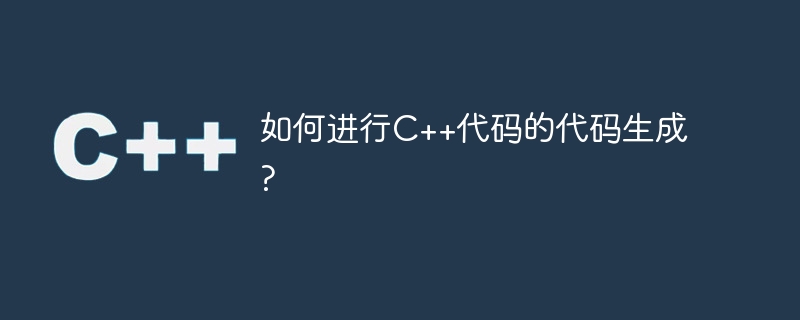Home >Backend Development >C++ >How to perform code generation of C++ code?
How to perform code generation of C++ code?
- WBOYWBOYWBOYWBOYWBOYWBOYWBOYWBOYWBOYWBOYWBOYWBOYWBOriginal
- 2023-11-02 15:46:481396browse

How to generate C code?
Code generation is an important link in software development, which can improve development efficiency and code quality. For C development, code generation is even more important. This article will introduce how to generate C code to help developers improve development efficiency and code quality.
- Using template libraries
Using template libraries is a common method for C code generation. C template is a flexible code generation mechanism that can automatically generate code based on type parameters. By defining template functions or template classes, developers can generate various types of code as needed.
For example, we can use container templates in STL (Standard Template Library) to generate specific types of container code. Simply put, STL provides template definitions for vector, list, map and other containers, and developers can generate relevant container code by specifying different data type parameters. In this way, we do not need to manually write different types of container code, but can achieve code reuse and automatic generation through the template library.
- Using macro definition
Macro definition is another commonly used code generation method in C. By using macro definitions, we can achieve automated generation and expansion of code. Developers can define some general macros and then use these macros where specific code needs to be generated. Macro definitions can include functions, classes, variables, etc., and can generate a large amount of code as needed.
For example, we can define a macro to generate a simple class definition:
#define DEFINE_CLASS(name)
class name {
public:
int getValue() { return value; }
void setValue(int val) { value = val; }
private:
int value;
};Then, use the macro where the class needs to be generated:
DEFINE_CLASS(MyClass)
This way As a result, we can use macros to achieve automatic code generation where many classes need to be generated.
- Use code generation tools
In addition to using template libraries and macro definitions, we can also use specialized code generation tools to generate C code. These tools can automatically generate code based on specific rules and configuration files. Developers only need to define the code generation specifications and the type of code to be generated, and the tool can automatically generate the corresponding code according to the rules.
The more commonly used C code generation tools include CMake, Jinja2, Bison, etc. These tools provide rich functions and flexible configuration options, and can generate various types of code according to the needs of the project.
- Use scripting language to assist in code generation
In addition, we can also use scripting language to assist in C code generation. Scripting language has concise syntax and powerful expression ability, and can dynamically generate C code by writing script programs.
The more commonly used scripting languages include Python, Lua, JavaScript, etc. Developers can choose the appropriate scripting language according to project needs and write corresponding script programs to assist in code generation.
Summary:
The above are several commonly used methods for C code generation. Different methods are suitable for different scenarios and needs, and developers can choose the appropriate method according to their own project conditions. Through code generation, development efficiency can be improved, development costs can be reduced, hand-written duplicate codes can be avoided, and code quality can be improved. Therefore, mastering code generation technology is very important for C developers.
The above is the detailed content of How to perform code generation of C++ code?. For more information, please follow other related articles on the PHP Chinese website!
Related articles
See more- C++ compilation error: A header file is referenced multiple times, how to solve it?
- C++ compilation error: wrong function parameters, how to fix it?
- C++ error: The constructor must be declared in the public area, how to deal with it?
- Process management and thread synchronization in C++
- How to deal with data splitting problems in C++ development

